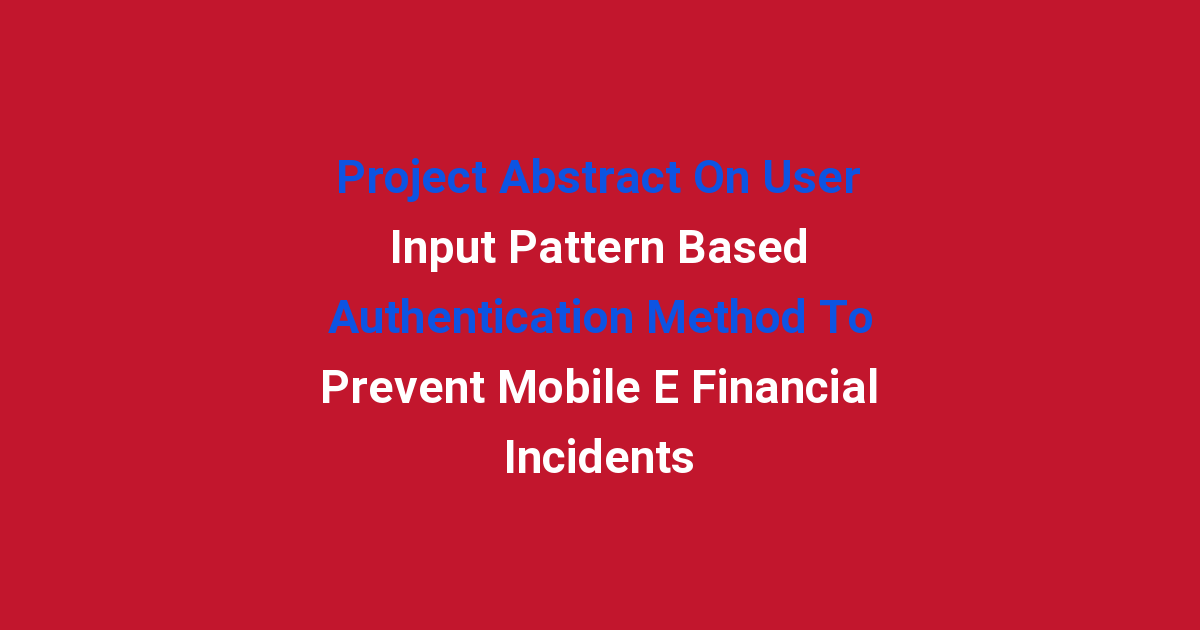This project abstract focuses on implementing a user input pattern-based authentication method to enhance security and prevent mobile e-financial incidents.
Project Abstract: User Input Pattern Based Authentication Method to Prevent Mobile E-Financial Incidents
Introduction
In this modern era of technology, mobile e-financial transactions have become incredibly popular. With the convenience of mobile banking, it has never been easier to manage one’s finances on the go. However, with this convenience comes a new set of challenges, particularly in the area of security. Cyber attacks and fraudulent activities targeting mobile e-financial transactions have been on the rise in recent years, posing a serious threat to users’ sensitive financial information.
To address these security concerns, it is crucial to implement effective authentication methods to ensure the safety and security of users’ financial data. In this project, we aim to develop a user input pattern-based authentication method to prevent mobile e-financial incidents, thereby enhancing the security of mobile e-financial transactions.
Problem Statement
The existing authentication methods used in mobile e-financial transactions, such as passwords and PIN codes, are vulnerable to various security threats. These traditional methods can be easily compromised through techniques such as phishing, malware attacks, and brute force attacks. As a result, users’ financial information is at risk of being accessed by unauthorized parties, leading to potential financial losses and fraud incidents.
Existing System
In the existing system, users are typically required to enter a password or PIN code to authenticate themselves and access their mobile e-financial accounts. While these methods have been widely used for authentication purposes, they are no longer sufficient to protect against sophisticated cyber attacks. Passwords can be easily guessed or stolen, while PIN codes can be intercepted or cracked using advanced hacking techniques.
Disadvantages
– Vulnerability to phishing attacks: Users may fall victim to phishing scams where attackers trick them into revealing their passwords or PIN codes.
– Susceptibility to brute force attacks: Hackers can use automated tools to guess passwords or PIN codes through trial and error.
– Lack of user-friendliness: Remembering complex passwords or PIN codes can be challenging for users, leading to potential security risks.
– Limited security: Traditional authentication methods do not provide adequate protection against emerging security threats in mobile e-financial transactions.
Proposed System
To address the limitations of the existing system, we propose a user input pattern-based authentication method for mobile e-financial transactions. This method will require users to input a unique pattern, such as a sequence of gestures or swipes, to authenticate themselves and access their financial accounts. The user input pattern will be personalized and difficult to replicate, providing an added layer of security to prevent unauthorized access.
Advantages
– Enhanced security: User input pattern-based authentication offers a higher level of security compared to traditional methods like passwords and PIN codes.
– Personalized authentication: Each user will create a unique input pattern, making it more difficult for attackers to replicate or guess.
– User-friendly: Gestures and swipes are intuitive and easy for users to remember, enhancing the user experience in mobile e-financial transactions.
– Robust protection: The user input pattern method is resistant to common hacking techniques such as phishing and brute force attacks, minimizing the risk of unauthorized access.
Features
The user input pattern-based authentication method will include the following features:
– Customizable input patterns: Users can create their own unique patterns based on gestures, swipes, or taps.
– Multi-factor authentication: The system can be configured to require additional authentication factors for increased security.
– Real-time monitoring: The system will monitor user input patterns in real-time to detect and prevent fraudulent activities.
– Secure encryption: Input patterns will be securely encrypted to protect users’ sensitive financial information from unauthorized access.
Conclusion
In conclusion, the user input pattern-based authentication method proposed in this project offers a viable solution to enhance the security of mobile e-financial transactions. By adopting this innovative authentication method, users can protect their financial information from potential cyber threats and fraudulent activities. With its personalized and user-friendly approach, the user input pattern method provides a robust and effective way to prevent mobile e-financial incidents and safeguard users’ financial data.

